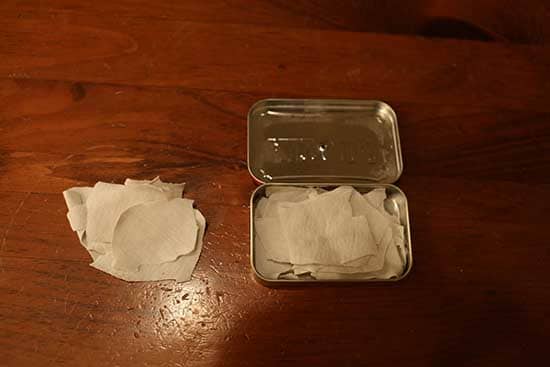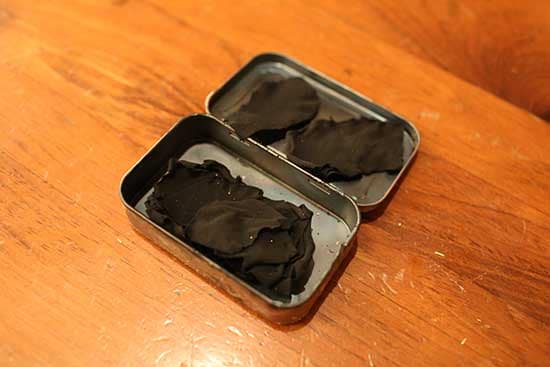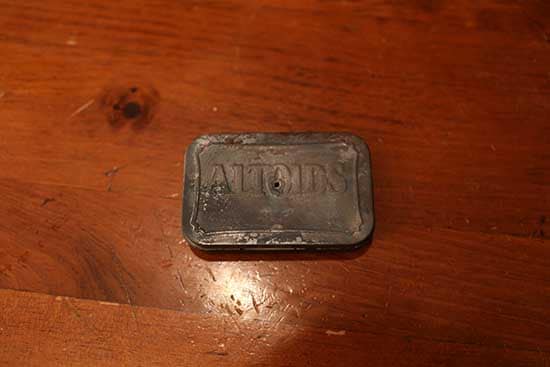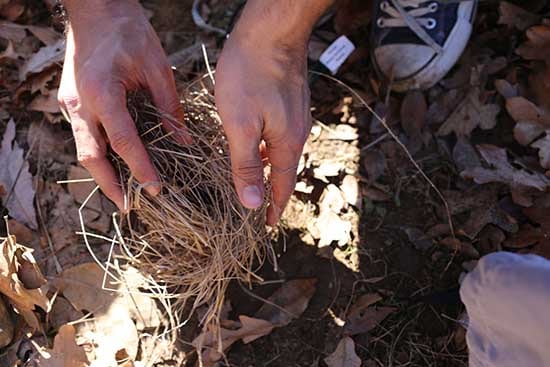
To make a spark that can light a fire, all you need is flint, tinder, and some good old fashioned friction. It’s a fire-making method that’s been around for thousands of years. But sparks are tiny, delicate things, so if you want to turn one into a roaring flame, you have to be deliberate about it. Directing a spark onto a pile of kindling won’t do much; even placing one into a pile of small, thin tinder may not set it aflame, especially if it’s damp. Thus, the best thing to do is to catch your spark in something slow-burning, but highly combustible, which can then light your tinder, which can then ignite your kindling, which can in turn set your larger logs ablaze. Going from spark to fire is all about working in deliberate stages.
What’s your best bet for successfully initiating the first step in the process? Char cloth. Today we’ll tell you what it is and the simple method of making a supply of your own.
What Is Char Cloth?
Char cloth has been used to make fires for centuries, and for good reason — it’s lightweight, compact, easy to make, and highly effective in igniting tinder.
Char cloth is created through a process of pyrolysis, which Wikipedia tells us is the “thermochemical decomposition of organic material at elevated temperature in the absence of oxygen.†Basically, char cloth is created by combusting an organic material in a way that releases its gasses without burning it up completely.
The resulting substance has a low ignition temperature — just a single spark or point of heat can start it burning. What can be used as the source of that heat? An empty lighter, flint and steel, firesteel, a lens, even a condom can do the trick (see this article for more ways to make a fire without matches). Once the char cloth has been set off, it will ignite your tinder easier than had you employed the original spark/heat source directly to it. Char cloth smolders longer than a match, making it advantageous in getting slightly damp tinder going, and while matches can fail on a windy day, a sturdy breeze can actually help get a spark-ignited piece of char cloth going.
Char cloth can thus be a life-saver in survival situations and makes an excellent addition to one’s camping supplies or bug out bag. And outside its fire-making benefits, making some is actually a pretty fun little science experiment!
How to Make Char Cloth
Supplies Needed:

- Sealable tin can. An empty, clean shoe polish can, Altoids tin, metal Band-Aid can (do they still make those?), etc. To make a larger batch of char cloth, you can use a coffee can sealed with foil on the top.
- 100% cotton material. An old t-shirt, pair of jeans, handkerchief, canvas, etc. Fabrics that contain artificial fibers will not result in a combustible material, so make sure it’s 100% cotton. Other organic materials like burlap can work too.
- Scissors
- Nail, or other puncturing tool

Step 1: To ensure complete, uniform charring, cut your cotton material into strips/pieces that can be placed into your can without their being rolled or folded up.

Step 2: Make a small hole in the top of your can with a nail or other tool. The hole will allow the smoke/gasses out of the can. You don’t want the hole too big, as this will let oxygen into the can, causing the cloth to burn.

Step 3: Seal the container and place it on a small fire or a bed of coals. Smoke should escape from the hole in the can. If flames appear around it, that’s okay. Watch the can, and once it has stopped smoking, turn it over. It will begin to smoke again. Once this smoke has stopped, remove the can from the fire.

Step 4: Inspect your char cloth. It should have turned black but not become ash, and feel semi-rigid without being brittle.

Step 5: Separate the pieces to give them a little air, and then either store them in the charred can (wipe off the soot and peeling paint) or in something more compact, like an old film canister (do they make those anymore either?).
Making Fire With Your Char Cloth
When a piece of char cloth catches a spark, it easily burns, but it doesn’t flame up. So you can’t put it right into a bunch of kindling. Instead, you want to place it a tinder bundle. A tinder bundle can be made from all sorts of fibrous and fluffy materials such as dried grasses, lichens, seed heads, and the bark shavings of cedar, birch, poplar, aspen, and cottonwood trees. Shred your material up into stringy fibers and then work them into a nest shape that’s about the size of a softball. You don’t want to pack your nest too tightly; allow room for airflow.
If you’re using flint and steel to make your spark, hold the flint in your left hand and your steel striker in your right. Hold a piece of char cloth between your flint and your thumb. You can also put your char cloth directly onto your tinder nest, and direct your sparks onto it.

Here I’m using a handy firesteel rod to light my char cloth.

Once you light your char cloth, place it in the center of your tinder nest and gently fold the sides of the bundle towards the smoldering char cloth so they touch it.

Blow on the char cloth until your nest flames up.

Place your burning tinder bundle under a teepee of twigs, and you’ll soon have a roaring fire!


